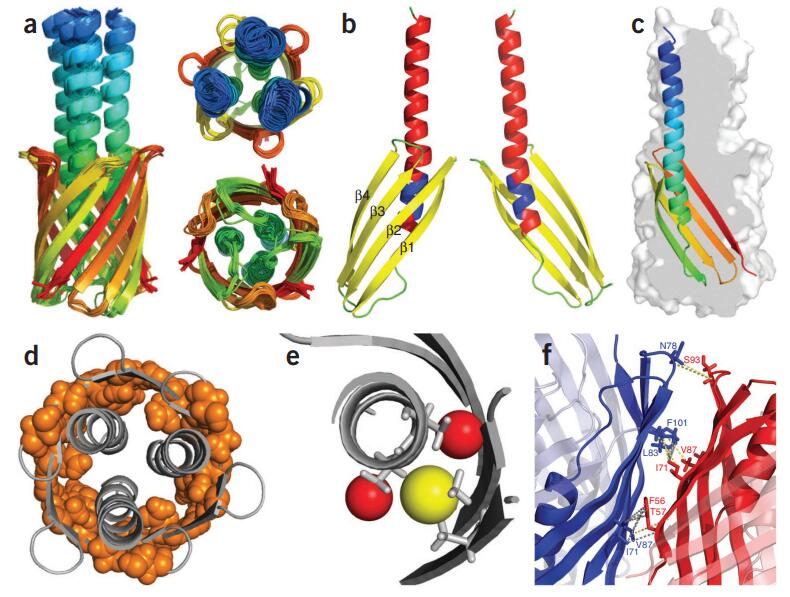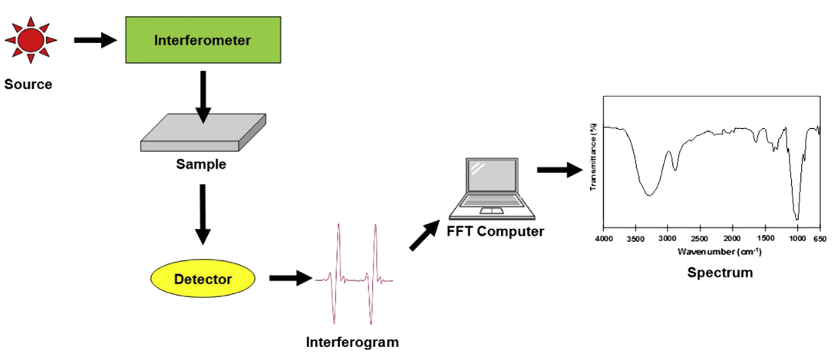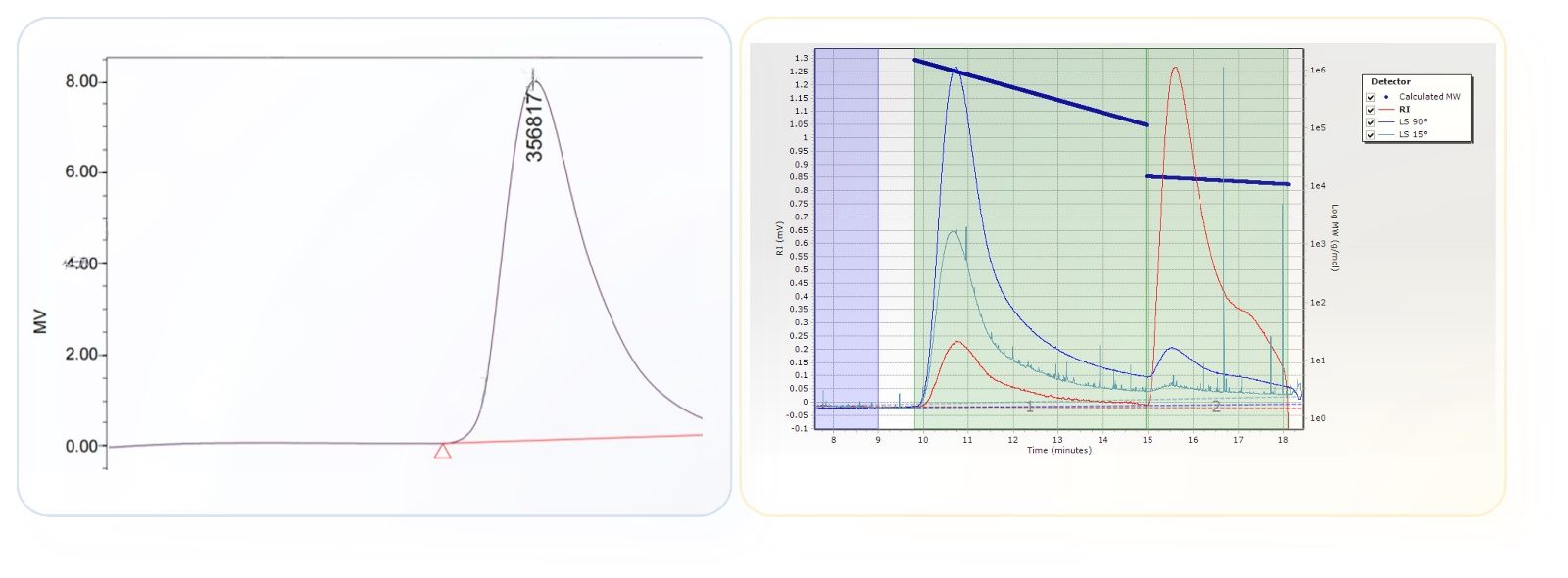Nuclear Magnetic Resonance (NMR) spectroscopy is a powerful tool for investigating polymer structures at the molecular level. It provides valuable insights into polymer composition, conformation, and dynamics, making it indispensable for materials science, pharmaceuticals, and biomaterials research.
Polymers play a critical role in industries ranging from medical applications to engineering and consumer goods. Understanding their structure is essential for controlling their properties and functions. Traditional techniques such as X-ray diffraction (XRD) and Fourier transform infrared (FTIR) spectroscopy provide useful information, but are often limited when analyzing complex polymer systems. NMR spectroscopy, on the other hand, provides atomic-level detail, allowing researchers to determine polymer composition, molecular dynamics, and structural conformations.
Creative Biostructure offers high-quality customized NMR spectroscopy services to meet your diverse needs, including polymer studies.

An Introduction to Polymers
Polymers are essential macromolecules composed of repeating monomeric units linked by covalent bonds. These versatile materials have transformed industries such as healthcare, electronics, automotive, packaging, and construction due to their wide range of properties and adaptability. Natural polymers such as DNA, proteins, and cellulose are fundamental to biological life, while synthetic polymers such as polyethylene, polystyrene, and nylon have revolutionized modern manufacturing.
Polymer Structure and Composition
Polymers are composed of monomers, which are small molecules that chemically bond to form long chains. The structure of a polymer significantly influences its properties and functions.
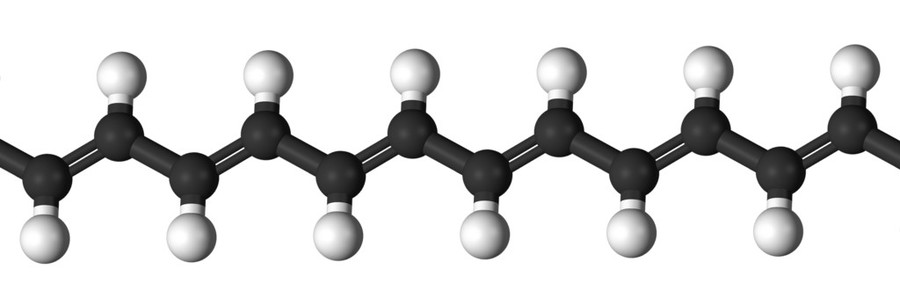 Figure 1. Ball and stick model of a section of a polymer chain of polyacetylene.
Figure 1. Ball and stick model of a section of a polymer chain of polyacetylene.
Basic Structure of Polymers
A polymer chain consists of a backbone of carbon, oxygen, nitrogen, or silicon atoms, depending on the type of polymer. These chains can be:
- Linear: Monomers are arranged in a straight sequence, resulting in flexible polymers (e.g., polyethylene).
- Branched: Side chains emerge from the main backbone, affecting properties like density and melting point (e.g., low-density polyethylene).
- Cross-linked: Chains are interconnected by covalent bonds, making the polymer rigid and thermally stable (e.g., vulcanized rubber).
- Network Polymers: Highly interconnected structures, often found in resins and epoxy materials.
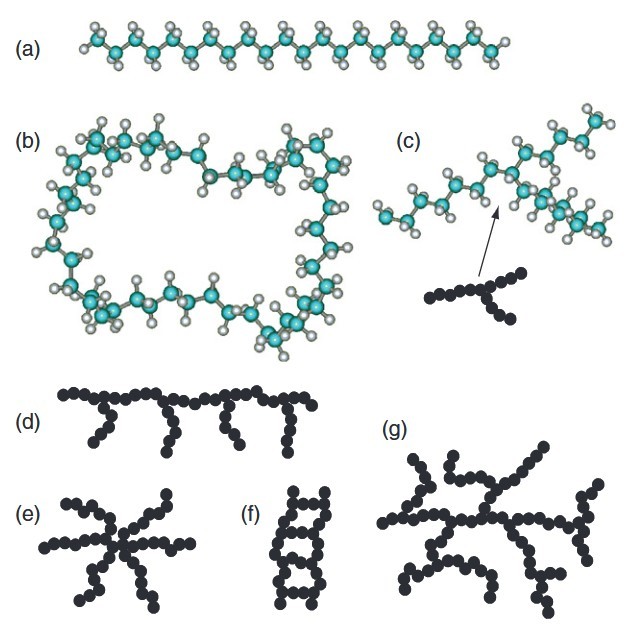 Figure 2. (a) Linear PE chain. (b) Polymer ring, (-CH2-)48. (c) PE chain with one branching point. (d) Comb-like polymer. (e) Star-like polymer. (f) Ladder polymer. (g) Randomly branched polymer. (Semenov and Nyrkova, 2012)
Figure 2. (a) Linear PE chain. (b) Polymer ring, (-CH2-)48. (c) PE chain with one branching point. (d) Comb-like polymer. (e) Star-like polymer. (f) Ladder polymer. (g) Randomly branched polymer. (Semenov and Nyrkova, 2012)
Molecular Weight of Polymers
The molecular weight of a polymer, which is determined by the number of repeating units, significantly affects its mechanical and thermal properties. Polymers with higher molecular weights tend to have greater strength and durability.
Complexity of Polymer Structures
Polymers are macromolecules composed of repeating monomer units, but their structures can vary widely in complexity. Factors such as molecular weight, branching, stereochemistry, and cross-linking influence polymer properties. Some polymers are simple linear chains, while others form intricate networks or block copolymers with distinct domain structures. Understanding this complexity is essential to tailoring polymer materials for specific applications.
Types of Polymers
Polymers can be classified based on their origin, structure, and polymerization process, molecular structure, and properties.
| Classification Principle | Type | Description | Example |
|---|---|---|---|
| Based on Origin | Natural Polymers | Found in biological systems |
|
| Synthetic Polymers | Artificially engineered for specific applications |
|
|
| Based on Polymerization Process | Addition Polymers | Formed by the successive addition of monomers without by-product formation | Polyethylene, polystyrene |
| Condensation Polymers | Formed via a reaction that releases small molecules, such as water or methanol, as by-products | Polyesters, nylons | |
| Based on Molecular Structure | Linear Polymers | Single, unbranched chains | High-density polyethylene |
| Branched Polymers | Side chains attached to the main chain | Low-density polyethylene | |
| Cross-linked Polymers | Interconnected polymer chains forming a network | Epoxy resins | |
| Based on Thermal Behavior | Thermoplastics | Soften upon heating and harden upon cooling, making them recyclable | Polypropylene, polycarbonate |
| Thermosets | Harden irreversibly upon heating due to cross-linking | Epoxy, Bakelite |
Importance of Understanding Polymer Structure
The structure of a polymer determines its physical, mechanical and chemical properties. For example, crystalline vs. amorphous regions affect strength and flexibility, while molecular weight distribution affects viscosity and processability. Structural insight helps design high-performance materials for industries ranging from plastics and coatings to biomaterials and drug delivery. Nuclear magnetic resonance (NMR) spectroscopy is a powerful tool for elucidating these structures, providing detailed information at both the molecular and macroscopic levels.
Principles of NMR in Polymer Studies
NMR spectroscopy is based on the interaction of nuclear spins with an external magnetic field. When placed in a magnetic field, certain nuclei (e.g., ¹H, ¹³C, ¹⁵N, and ³¹P) absorb electromagnetic radiation at specific resonance frequencies. The chemical environment influences these frequencies, allowing researchers to derive structural and dynamic information about the polymer.
Key NMR parameters used in polymer studies include:
- Chemical shifts (δ): Indicate the electronic environment of nuclei, helping in identifying monomer compositions and chain sequences.
- Spin-spin coupling (J-coupling): Provides information on the connectivity between atoms, useful in determining polymer branching and end groups.
- Relaxation times (T1 and T2): Reveal molecular mobility and segmental dynamics, crucial for understanding polymer flexibility and phase transitions.
NMR Techniques for Polymer Structure Analysis
Solution-State NMR
Solution-state NMR is commonly used for soluble polymers and provides high-resolution spectral data. The key techniques include:
- ¹H NMR: Used to identify polymer composition and tacticity (stereoregularity). For example, in polypropylene, different methyl group resonances distinguish isotactic, syndiotactic, and atactic configurations.
- ¹³C NMR: Provides detailed insights into backbone structure and monomer sequences, particularly useful for copolymer analysis.
- Diffusion-Ordered Spectroscopy (DOSY): Helps differentiate polymer components based on their diffusion coefficients, useful for studying polymer blends and molecular weight distributions.
Solid-State NMR (SSNMR)
Solid-state NMR (ssNMR) is particularly useful for the analysis of insoluble or semicrystalline polymers. Unlike solution-state NMR, which requires sample dissolution, SSNMR can probe the molecular structure of polymers in their native solid state. This technique provides information on chain mobility and dynamics, crystallinity and phase separation, and intermolecular interactions in polymer mixtures. Important SSNMR techniques include:
- Cross-Polarization Magic Angle Spinning (CP-MAS): Enhances sensitivity in ¹³C NMR, providing detailed information on polymer crystallinity and morphology.
- Wide-Line NMR (WLINMR): Used to study polymer dynamics in semicrystalline and amorphous materials.
- 2D NMR (e.g., HSQC, NOESY): Helps in identifying intermolecular interactions and chain connectivity.
GPC-NMR (Gel Permeation Chromatography-NMR)
Gel Permeation Chromatography (GPC) is a widely used technique for determining polymer molecular weight distribution. When coupled with NMR, it provides both molecular weight and structural information simultaneously. GPC-NMR is particularly useful for:
- Identifying structural variations across different molecular weight fractions
- Distinguishing between homopolymers and block copolymers
- Tracking polymer degradation by monitoring molecular weight changes
Select Service
Applications of NMR in Polymer Studies
| Polymer Characterization | Identifying and Quantifying Different Polymer Species | Quality Control in Polymer Manufacturing: Ensuring that polymer products meet predefined structural and compositional specifications by detecting impurities or deviations in monomer content. |
| Consistency in Polymer Formulations: Confirming batch-to-batch uniformity, which is critical for maintaining mechanical, thermal, and chemical properties in industrial applications. | ||
| Differentiation of Structurally Similar Polymers: Distinguishing between polymers that have similar molecular weights or elemental compositions but differ in their microstructure or monomer arrangement. | ||
| Analyzing Copolymers and Polymer Blends | Block Lengths and Sequence Distribution: Providing insights into the arrangement of monomer units within a polymer, which directly impacts mechanical properties and functionality. | |
| Interfacial Mixing in Polymer Blends: Assessing how different polymer components interact at the molecular level, which influences material compatibility and performance. | ||
| Miscibility and Phase Separation Behavior: Investigating how well different polymer species mix or separate, crucial for applications in coatings, adhesives, and nanocomposites. | ||
| Polymer Synthesis | Monitoring Polymerization Processes | Identifying Unreacted Monomers: Detecting residual monomers ensures complete polymerization and minimizes unwanted byproducts. |
| Determining Reaction Kinetics and Polymer Growth Rates: Quantifying how quickly monomers are incorporated into polymer chains, helping to optimize reaction conditions for desired polymer properties. | ||
| Detecting Side Reactions and Byproducts: Identifying unintended chemical transformations that may alter polymer functionality, enabling process adjustments to improve yield and purity. | ||
| Controlling Molecular Weights and Confirming Monomer Sequences | Measuring Polymer Chain Length via End-Group Analysis: Identifying terminal groups in polymer chains helps in determining molecular weight distributions. | |
| Verifying Monomer Incorporation in Copolymerization Reactions: Confirming the ratio and sequence of monomers ensures the desired material characteristics. | ||
| Ensuring Batch-to-Batch Reproducibility in Polymer Production: Helping maintain consistent polymer properties for large-scale industrial applications. | ||
| Material Science | Studying Polymer Degradation | Identifying Oxidation and Hydrolysis Products: Detecting chemical changes due to exposure to oxygen, moisture, and other environmental factors. |
| Monitoring Structural Breakdown in Biodegradable Polymers: Evaluating polymer decomposition rates for applications in sustainable packaging and biomedical implants. | ||
| Evaluating Long-Term Material Performance: Assessing how prolonged exposure to heat, light, or chemicals affects polymer integrity. | ||
| Analyzing Changes in Molecular Structure Under Different Conditions | Glass Transition and Phase Transitions: Investigating molecular mobility and phase behavior at different temperatures. | |
| Crosslinking and Curing in Thermosets: Monitoring polymer network formation, which is critical in applications such as coatings, adhesives, and composite materials. | ||
| Solvent-Induced Swelling and Plasticization: Studying how polymer properties change upon exposure to solvents, which is essential for applications such as drug delivery and flexible electronics. | ||
| Biomaterials and Biopolymers | Investigating the Structure of Natural Polymers and Biomaterials | Polysaccharides (e.g., Cellulose, Chitosan): Determining glycosidic linkages and molecular conformation crucial for applications in pharmaceuticals and bio-based materials. |
| Proteins and Peptide-Based Biomaterials: Studying secondary and tertiary structures for applications in drug delivery and regenerative medicine. | ||
| DNA-Based Polymer Systems: Investigating interactions with drugs and other biomolecules, important in gene therapy and biotechnology. | ||
| Applications in Biomedical Research | Designing Drug Delivery Systems Based on Polymeric Micelles and Hydrogels: Assessing molecular interactions that affect drug loading and release properties. | |
| Characterizing Bioresorbable Scaffolds for Tissue Engineering: Evaluating degradation rates and mechanical properties of scaffolds for regenerative medicine. | ||
| Investigating Protein-Polymer Conjugates for Targeted Therapies: Understanding molecular compatibility and functionality in hybrid biomaterials used for personalized medicine. |
Case Study
Case 1: Analysis of Chain Branch of Polyolefins by a New Proton NMR Approach
The crystallinity of polyethylene significantly affects its mechanical and thermal properties, and since it is highly sensitive to branch concentration, accurate estimation of this concentration is critical for polymer characterization. ¹³C NMR requires highly concentrated samples and has a long analysis time of more than 12 hours, while its sample preparation process is tedious and time-consuming. To address these challenges, researchers developed a high-field ¹H NMR method with improved peak resolution, incorporating homonuclear decoupling for improved spectral clarity and 2D heteronuclear correlation for better structural insight. This new method significantly reduced experimental time to approximately 30 minutes, while simplifying sample preparation by eliminating the need for highly concentrated samples. As a result, the improved ¹H NMR approach provides a faster, more practical and equally accurate alternative to conventional methods for estimating branch concentration in polyethylene, making it a valuable advancement in polymer analysis.
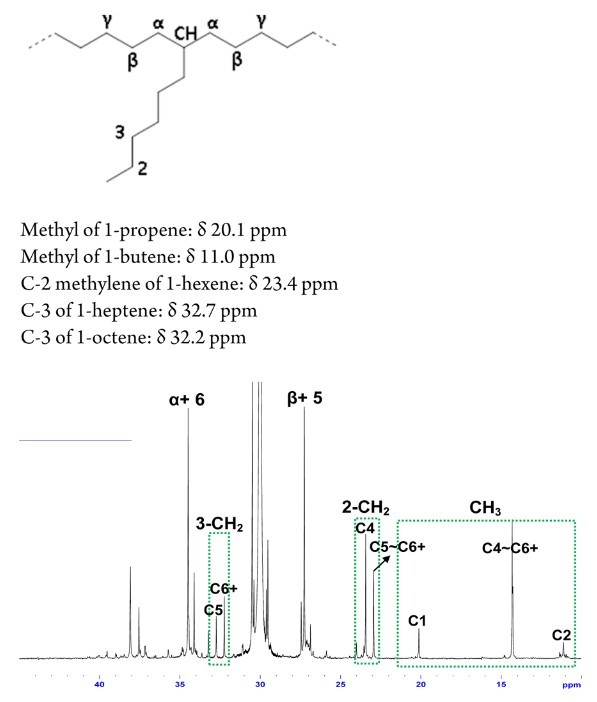 Figure 3. 13C NMR spectrum and carbon peak assignment of low-density polyethylene. (Jung et al., 2016)
Figure 3. 13C NMR spectrum and carbon peak assignment of low-density polyethylene. (Jung et al., 2016)
Case 2: Solid State NMR a Powerful Technique for Investigating Sustainable/Renewable Cellulose-Based Materials
Solid-state nuclear magnetic resonance (ssNMR) is a powerful technique for analyzing the chemical structure and dynamics of various materials, including cellulose-based polymers. With the growing interest in sustainable and renewable cellulosic materials, ssNMR plays a crucial role in investigating their molecular packing, chain motion, functional modifications and solvent interactions, all of which influence their properties and applications. Compared to other spectroscopic methods, ssNMR provides more detailed structural insights at the atomic level; however, its full potential is often underutilized due to the limited availability of pulse sequences and the time-consuming nature of the experiments. This review highlights recent advances in ssNMR strategies aimed at overcoming these challenges and improving the structural analysis of cellulose-based materials.
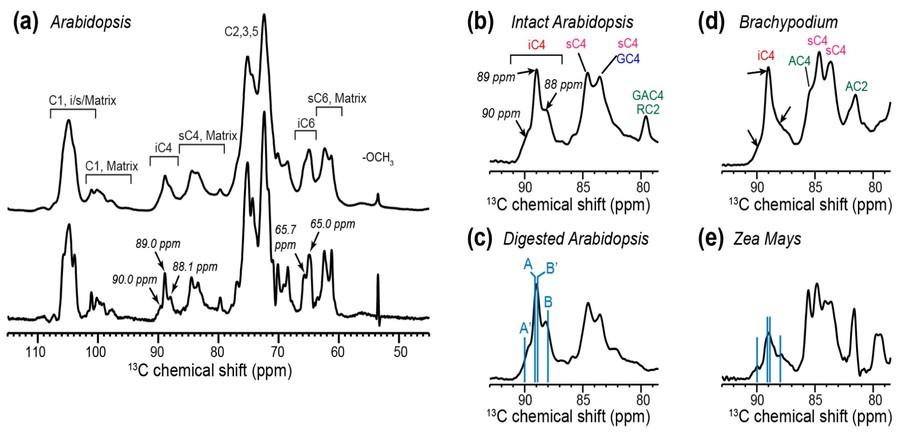 Figure 4. 1D 13C CP MAS NMR spectra of primary cell walls with high magnetic fields. (a) Undried Arabidopsis cell walls without (top) and with (bottom) resolution-enhanced window function. (b) Intact Arabidopsis cell wall. (c) Partially digested Arabidopsis cell wall. (d) Brachypodium cell wall. (e) Zea mays cell wall. Only the C4 region of the 13C spectra of various cell walls is shown in (b–e). Blue lines in (c,e) indicate the crystalline cellulose C4 chemical shifts in Iα (A and A′) and Iβ (B and B′) allomorphs. (EI Hariri et al., 2022)
Figure 4. 1D 13C CP MAS NMR spectra of primary cell walls with high magnetic fields. (a) Undried Arabidopsis cell walls without (top) and with (bottom) resolution-enhanced window function. (b) Intact Arabidopsis cell wall. (c) Partially digested Arabidopsis cell wall. (d) Brachypodium cell wall. (e) Zea mays cell wall. Only the C4 region of the 13C spectra of various cell walls is shown in (b–e). Blue lines in (c,e) indicate the crystalline cellulose C4 chemical shifts in Iα (A and A′) and Iβ (B and B′) allomorphs. (EI Hariri et al., 2022)
Unlock deeper insights into your polymer research with Creative Biostructure's expert NMR services. Whether you need high-resolution solution-state NMR for compositional analysis or solid-state NMR for studying complex polymer matrices, our advanced techniques ensure accurate and reliable results. Contact us today to discuss your project and discover how our NMR expertise can help you achieve your analytical goals!
References
- EI Hariri EM, Habib MH, Alassmy YA, Abduljawad MM, Alshamrani KM, Sebakhy KO. Solid state NMR a powerful technique for investigating sustainable/renewable cellulose-based materials. Polymers. 2022;14(5):1049. doi:10.3390/polym14051049
- Jung M, Lee Y, Kwak S, et al. Analysis of chain branch of polyolefins by a new proton NMR approach. Anal Chem. 2016;88(3):1516-1520. doi:10.1021/acs.analchem.5b04357
- Meheta Datta, Kazi Madina Maraz, Naziza Rahman, Ruhul A. Khan. Application of polymer in biomedical implication. GSC Biol and Pharm Sci. 2021;14(2):098-114. doi:10.30574/gscbps.2021.14.2.0038
- Semenov AN, Nyrkova IA. Statistical description of chain molecules. In: Polymer Science: A Comprehensive Reference. Elsevier; 2012:3-29. doi:10.1016/B978-0-444-53349-4.00002-9
